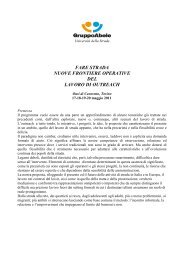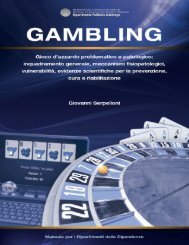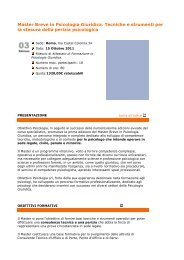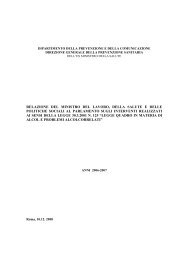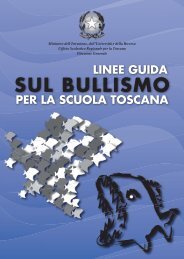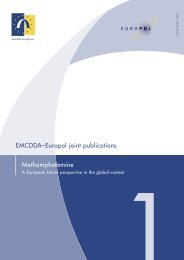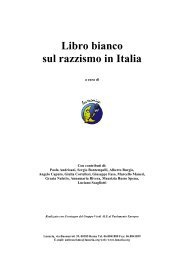Neuroscienze e dipendenze - Dipartimento per le politiche antidroga
Neuroscienze e dipendenze - Dipartimento per le politiche antidroga
Neuroscienze e dipendenze - Dipartimento per le politiche antidroga
You also want an ePaper? Increase the reach of your titles
YUMPU automatically turns print PDFs into web optimized ePapers that Google loves.
268 - E<strong>le</strong>menti di NEUROSCIENZE E DIPENDENZE<br />
sciati (Bjork JM 2004; 2007, 2008, 2009) è che gli<br />
studi sulla maturazione del cervello hanno creato una<br />
sorta di “entusiasmo” che rischia di creare confusione.<br />
Si può infatti essere portati a utilizzare come punto di<br />
riferimento <strong>per</strong> interpretare l’età evolutiva la maturità<br />
cerebra<strong>le</strong> tralasciando il modello della vulnerabilità. I<br />
ricercatori che sono stati citati in queste pagine sono<br />
molto chiari in proposito e indicano come punti di riferimento<br />
due principi: la maturità cerebra<strong>le</strong> e la vulnerabilità.<br />
Se in genera<strong>le</strong> tutti gli ado<strong>le</strong>scenti assumono maggiori<br />
rischi a causa di un natura<strong>le</strong> “sbilanciamento” che<br />
la maturazione precoce del sistema limbico comporta rispetto<br />
alla corteccia, bisogna considerare anche la presenza<br />
di fattori di rischio, cioè il concetto di “vulnerabilità”.<br />
Alla base di questo concetto c’è una teoria, secondo<br />
la qua<strong>le</strong> esiste una variabilità individua<strong>le</strong> che assieme alla<br />
maturità cerebra<strong>le</strong> può spiegare il fatto che alcuni ado<strong>le</strong>scenti<br />
siano particolarmente a rischio nell’assumere comportamenti<br />
<strong>per</strong>icolosi o devianti.<br />
CONCLUSIONI<br />
Tentando una sintesi conclusiva possiamo definire tre<br />
aspetti fondamentali sulla maturità e vulnerabilità cerebra<strong>le</strong>:<br />
– Aggiornamento: è un campo di studio relativamente<br />
nuovo nel qua<strong>le</strong> sono impegnati diversi gruppi di ricerca<br />
con una intensa produzione scientifica. Coloro<br />
che vogliono orientare la propria formazione in questo<br />
ambito debbono essere di grado di<br />
– Punti di riferimento: gli studi sulla maturità cerebra<strong>le</strong> da<br />
una parte e sulla vulnerabilità dall’altra sono ritenuti<br />
oggi indispensabili punti di riferimento <strong>per</strong> coloro che<br />
lavorando nell’ambito della prevenzione e della diagnosi<br />
precoce si trovano a dover identificare soggetti in età<br />
evolutiva che siano a rischio <strong>per</strong> tossicodipendenza<br />
– Motivazione: l’educatore spesso si trovare a dover spiegare<br />
e motivare <strong>le</strong> proprie scelte ai genitori e hai ragazzi.<br />
Quanto oggi conosciamo riguardo alla maturità<br />
cerebra<strong>le</strong> e alla vulnerabilità aiuta l’o<strong>per</strong>atore a sostenere<br />
<strong>le</strong> ragioni del<strong>le</strong> sue scelte.<br />
BIBLIOGRAFIA<br />
1. Bjork J.M., et al Ado<strong>le</strong>scent, adults and rewards: comparing motivational neurocircuity recruitment using fMRI. In press.<br />
2. Bjork J.M., Knutson B., Fong G.W., Caggiano D.M., Bennett S.M., Hommer D.W. Incentive-elicited brain activation in ado<strong>le</strong>scents: similarities<br />
and differences from young adults. J Neurosci. 2004 Feb 25; 24(8): 1793-802.<br />
3. Bjork J.M., Knutson B., Hommer DW. Incentive-elicited striatal activation in ado<strong>le</strong>scent children of alcoholics. Addiction. 2008<br />
Aug;103(8):1308-19<br />
4. Bjork J.M., Chen G., Smith A.R., Hommer D.W. Incentive-elicited mesolimbic activation and externalizing symptomatology in ado<strong>le</strong>scents.<br />
J Child Psychol Psychiatry. 2009 Dec 11<br />
5. Bjork J.M., Smith A.R., Danube C.L., Hommer D.W. Developmental differences in posterior mesofrontal cortex recruitment by risky rewards.<br />
J Neurosci. 2007 May 2; 27(18): 4839-49.<br />
6. Casey B.J., Getza S., Galvan A. The ado<strong>le</strong>scent brain. Dev Rev. 2008; 28(1): 62-77.<br />
7. Casey, B.J., Galvan, A., & Hare, T. (2005). Changes in cerebral functional organization during cognitive development. Current Opinions in<br />
Neurobiology, 15, 239-244.<br />
8. Giedd J.N., Blumenthal J., Jeffries N.O., Castellanos F.X., Liu H., Zijdenbos A., Paus T., Evans A.C., Rapoport J.L. Brain development during<br />
childhood and ado<strong>le</strong>scence: a longitudinal MRI study. Nat Neurosci. 1999 Oct; 2(10): 861-3.<br />
9. Ernst M., Nelson E.E., Jazbec S., McClure E.B., Monk C.S., Leibenluft E., Blair J., Pine D.S. Amygdala and nuc<strong>le</strong>us accumbens in responses<br />
to receipt and omission of gains in adults and ado<strong>le</strong>scents. Neuroimage 005; 25: 1279-1291.<br />
10. Ernst M., Korelitz K.E. Cerebral maturation in ado<strong>le</strong>scence: behavioral vulnerability Encepha<strong>le</strong>. 2009 Dec; 35 Suppl 6: S182-9.<br />
11. Eshel N., Nelson E.E., Blair R.J., Pine D.S., Ernst M. Neural substrates of choice se<strong>le</strong>ction in adults and ado<strong>le</strong>scents: development of the<br />
ventrolateral prefrontal and anterior cingulate cortices. Neuropsychologia. 2007 Mar 25; 45(6): 1270-9. Epub 2006 Nov 22.<br />
12. Ernst M., Nelson E.E., Jazbec S., McClure E.B., Monk C.S., Leibenluft E., Blair J., Pine D.S. Amygdala and nuc<strong>le</strong>us accumbens in responses<br />
to receipt and omission of gains in adults and ado<strong>le</strong>scents. Neuroimage. 2005 May 1; 25(4): 1279-91.<br />
13. Galvan A., Hare T.A., Parra C.E., Penn J., Voss H., Glover G., et al. Earlier development of the accumbens relative to orbitofrontal cortex<br />
might underlie risk-taking behavior in ado<strong>le</strong>scents. Journal of Neuroscience 2006; 26: 6885-6892.<br />
14. Galvan A., Hare T., Voss H., Glover G., Casey B.J. Risk-taking and the ado<strong>le</strong>scent brain: Who is at risk Developmental Science 2007; 10:<br />
F8-F14.<br />
15. Smith B.W., Mitchell D.G., Hardin M.G., Jazbec S., Fridberg D., Blair R.J., Ernst M. Neural substrates of reward magnitude, probability, and<br />
risk during a wheel of fortune decision-making task. Neuroimage. 2009 Jan 15; 44(2): 600-9. Epub 2008 Aug 27.



